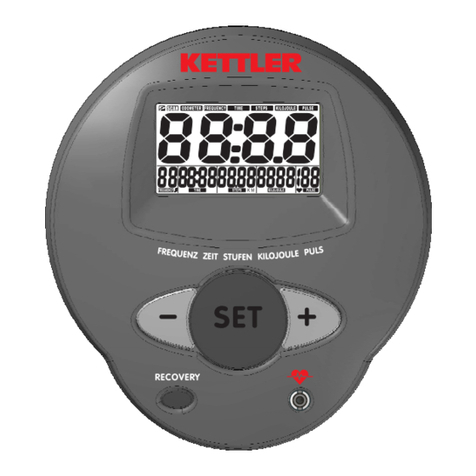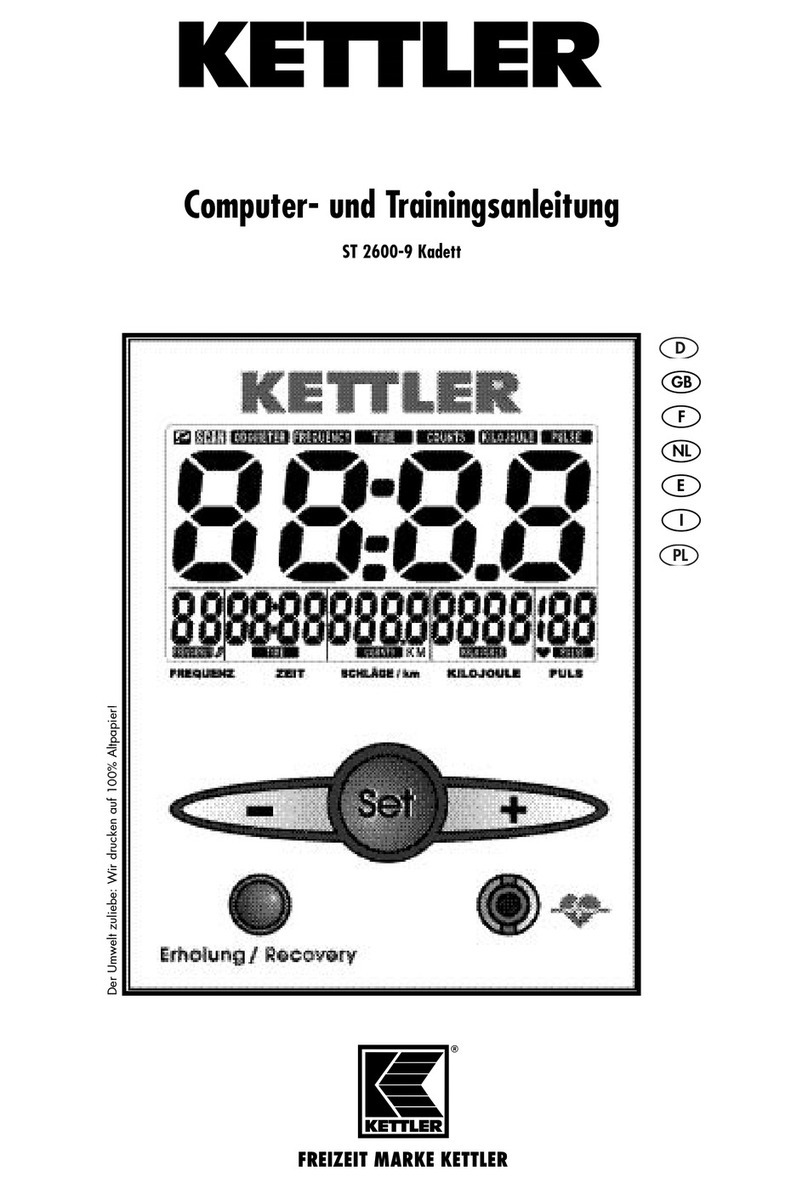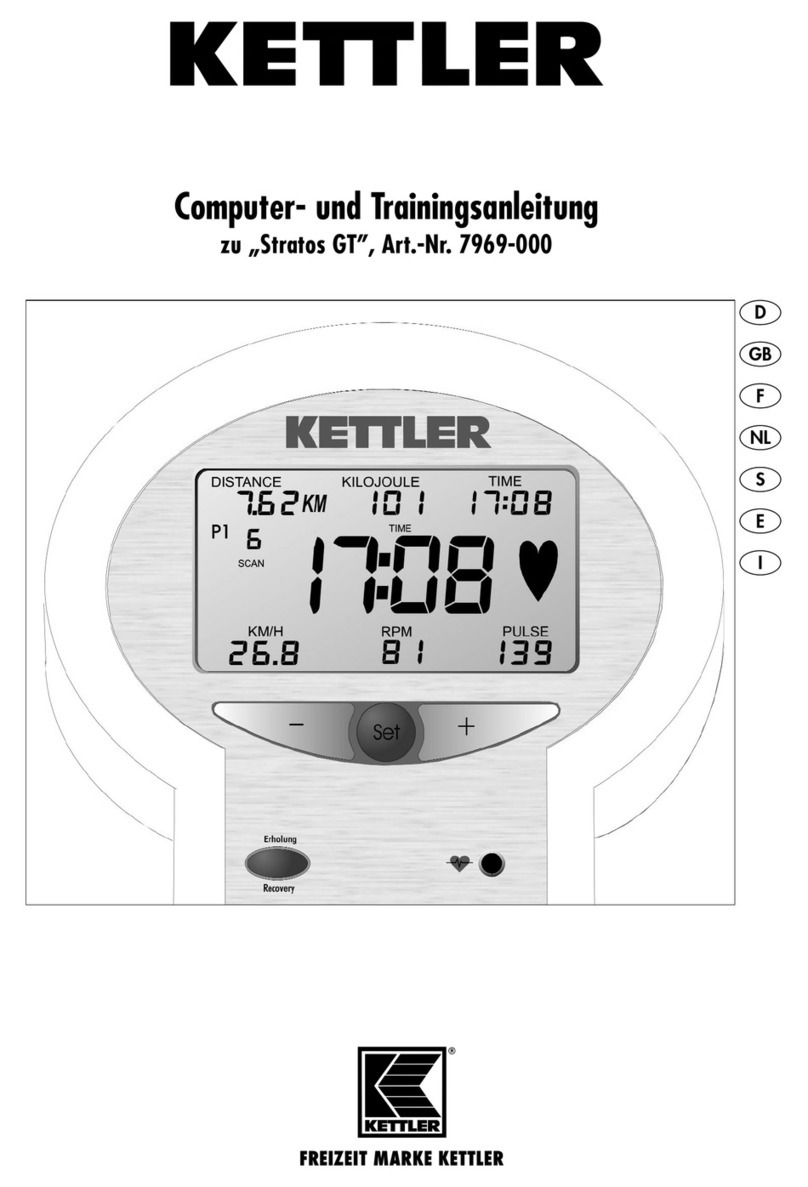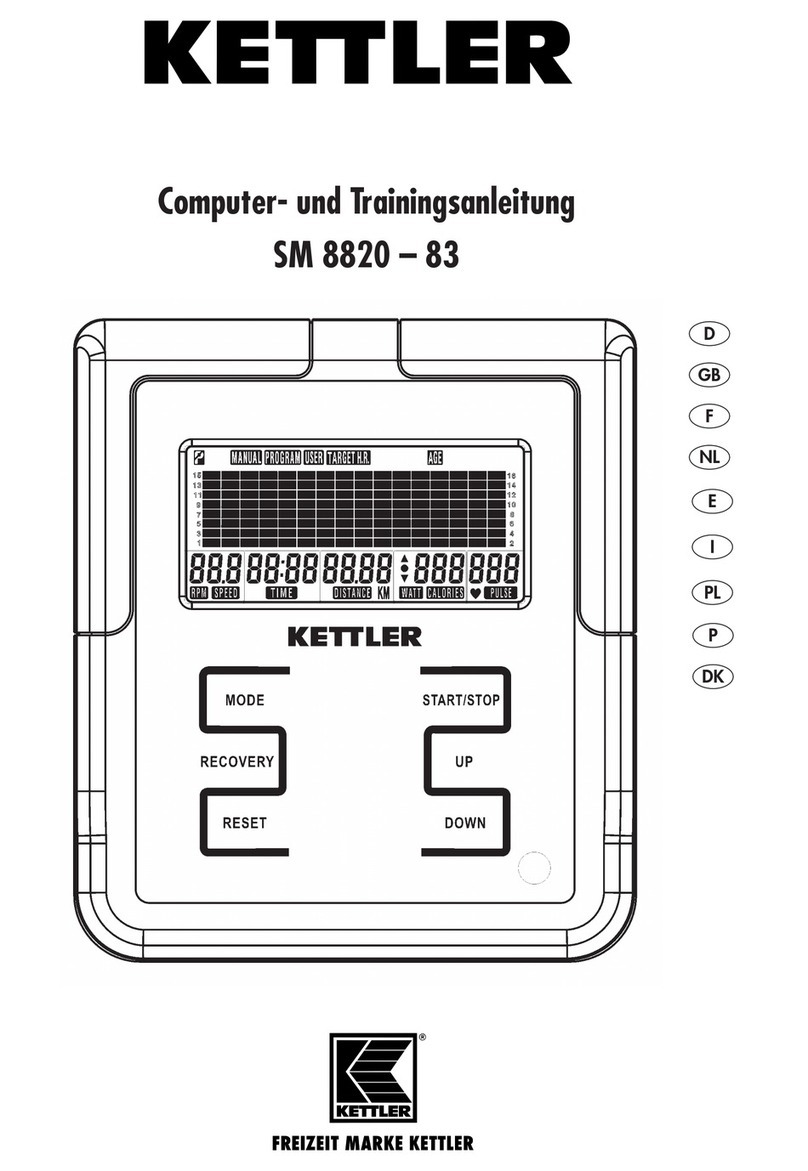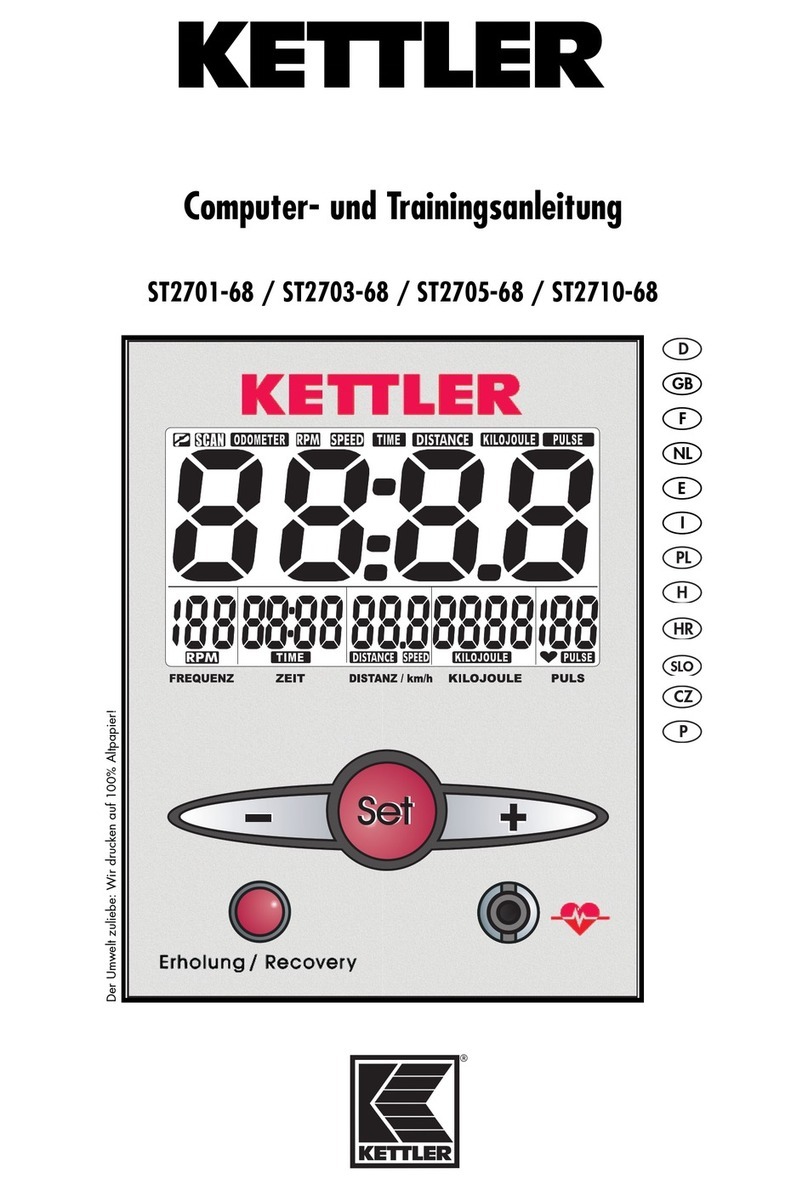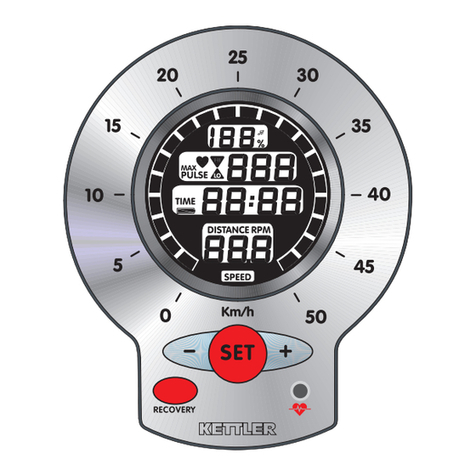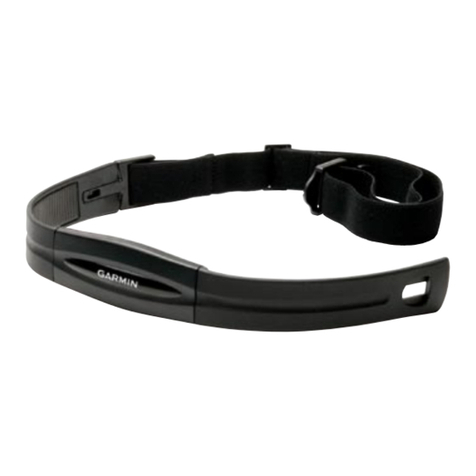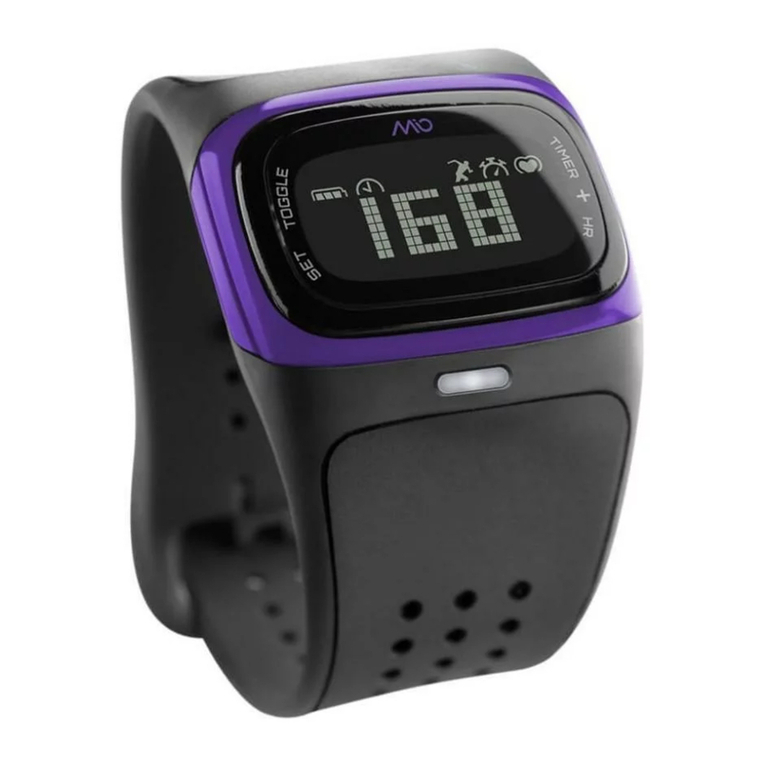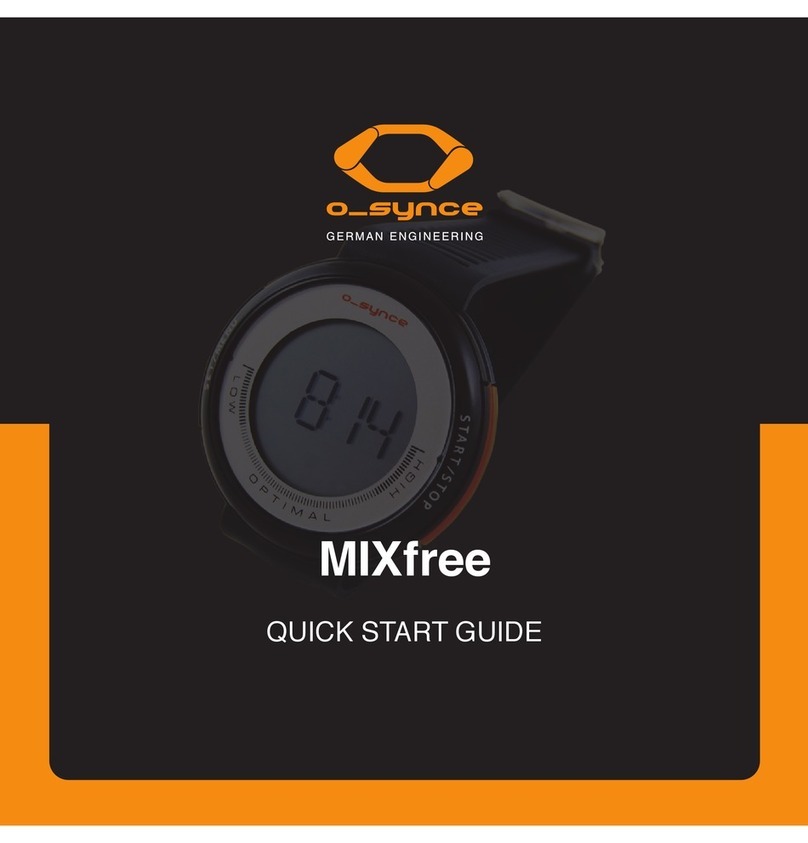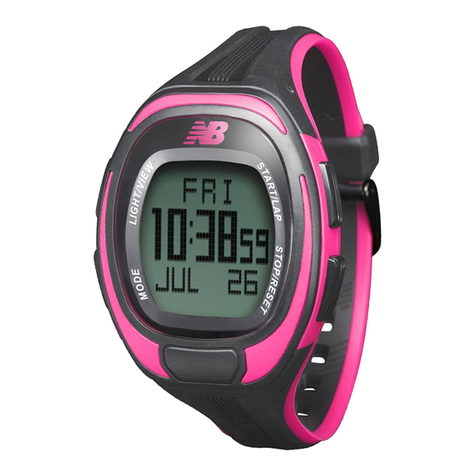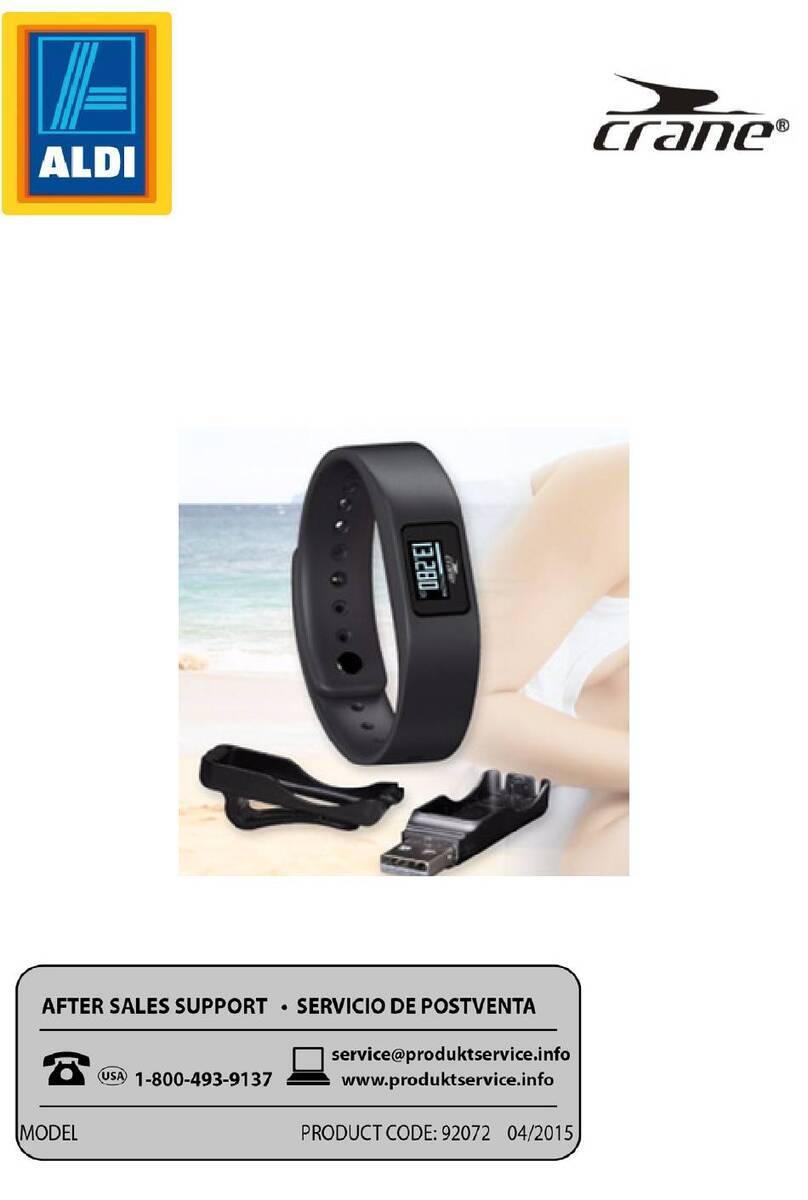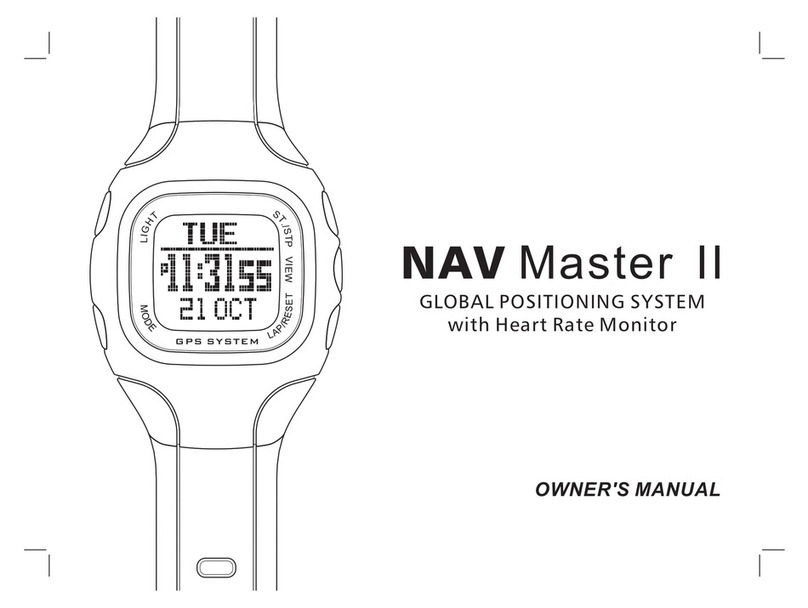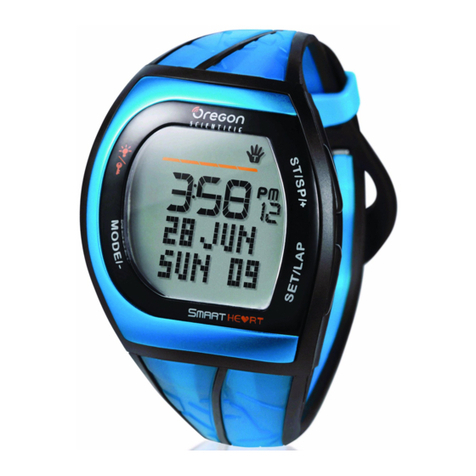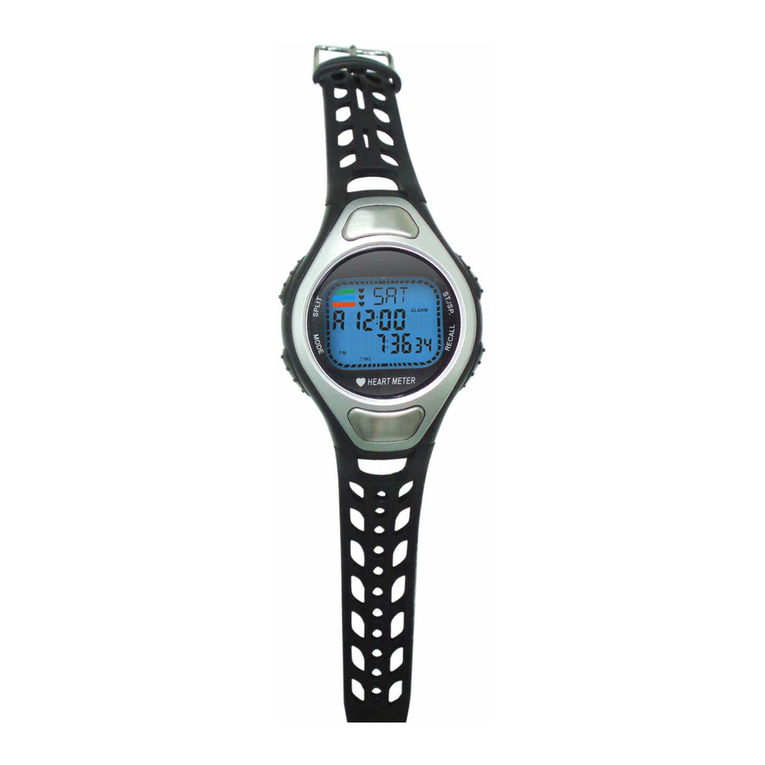8
•Befestigen Sie den Ohrclip sorgfältig an Ihrem Ohrläppchen und su-
chen Sie den günstigsten Punkt für die Abnahme (Herzsymbol blinkt
ohne Unterbrechnung auf).
•Trainieren Sie nicht direkt unter starkem Lichteinfall z.B. Neonlicht, Ha-
logenlicht, Spot - Strahler, Sonnenlicht.
•Schließen Sie Erschütterungen und Wackeln des Ohrsensors inclusive
Kabel vollkommen aus. Stecken Sie das Kabel immer mittels Klammer
an Ihrer Kleidung oder noch besser an einem Stirnband fest.
Mit Handpulssensoren
Eine durch die Kontraktion des Herzens erzeugte Kleinstspannung wird
durch die Handsensoren erfaßt und durch die Elektronik ausgewertet.
•Umfassen Sie die Kontaktflächen immer mit beiden Händen.
•Vermeiden Sie ruckartiges Umfassen
•Halten Sie die Hände ruhig und vermeiden Sie Kontraktionen und Rei-
ben auf den Kontaktflächen.
Mit Cardio Puls Set
Beachten Sie die dazugehörige Anleitung.
Störungen in der Pulsanzeige
Falls es doch einmal zu Pulserfassungsproblemen kommen sollte, überprü-
fen Sie nochmals obige Punkte.
Störungen beim Trainingscomputer
Verhält sich die Elektronik merkwürdig oder gestört drücken Sie die Reset-
Taste.
Hinweise zur Schnittstelle
Die bei Ihrem Fachhändler erhältliche Trainingssoftware „ERGO-Kon-
zept“, Art.-Nr. 7926-000, ermöglicht Ihnen die Steuerung mit einem
handelsüblichen PC über diese Schnittstelle.
Auf unserer Homepage www.kettler.net finden Sie demnächst Hin-
weise zu weiteren Möglichkeiten mit der Schnittstelle.
Unter dem Punkt F. A. Q. (häufig gestellte Fragen) finden Sie Informatio-
nen zum Themenbereich „Elektronik“ unserer Produkte.
10 Trainingsanleitung
Cross-Training ist ein sehr effektives Ganzkörpertraining, das alle
großen Muskelgruppen beansprucht und gleichzeitig auf ideale Weise
das Herz-Kreislauf-System trainiert und den Fettstoffwechsel fördert. Der
innovative elliptische Bewegungsablauf der Trittflächen kräftigt beson-
ders gelenkschonend die Bein- und Gesäßmuskulatur, das mit der Bein-
arbeit gekoppelte Oberkörpertraining beansprucht vornehmlich die Arm-
, Schulter-, Brust- und Rückenmuskulatur.
Bevor Sie mit dem Training beginnen, sollten Sie die folgenden Hinweise
sorgfältig lesen!
Wichtiger Hinweis:
Lassen Sie vor Aufnahme des Fitnesstrainings durch Ihren Hausarzt ab-
klären, ob Sie für das Training mit dem Cross-Trainer gesundheitlich ge-
eignet sind. Der ärztliche Befund sollte Grundlage für den Aufbau Ihres
Trainingsprogrammes sein.
Die o. g. und folgenden Trainingshinweise empfehlen sich nur für Herz-
Kreislauf-gesunde Personen.
Trainingshinweise
Das Training mit dem Cross-Trainer ist methodisch nach den Grundsätzen
des Ausdauertrainings zu gestalten. Durch das Ausdauertraining werden
vornehmlich Veränderungen und Anpassungen am Herz-Kreislaufsystem
hervorgerufen. Hierzu zählen das Absinken der Ruhepulsfrequenz und
des Belastungspulses. Damit steht für das Herz mehr Zeit für die Füllung
der Herzkammern und die Durchblutung der Herzmuskulatur (durch die
Herzkranzgefäße) zur Verfügung. Ferner nehmen Atemtiefe und Menge
der Luft zu, die eingeatmet werden kann (Vitalkapazität). Weitere positi-
ve Veränderungen finden im Stoffwechselsystem statt. Um diese positiven
Veränderungen zu erreichen, muß man das Training nach bestimmten
Richtlinien planen.
Planung und Steuerung Ihres Cross-Trainings
Die Grundlage für die Trainingsplanung ist Ihr aktueller körperlicher Lei-
stungszustand. Mit einem Belastungstest kann Ihr Hausarzt die persönli-
che Leistungsfähigkeit diagnostizieren, die die Basis für Ihre Trainings-
planung darstellt. Haben Sie keinen Belastungstest durchführen lassen,
sind in jedem Fall hohe Trainingsbelastungen bzw. Überlastungen zu ver-
meiden. Folgenden Grundsatz sollten Sie sich für die Planung merken:
Ausdauertraining wird sowohl über den Belastungsumfang als auch über
die Belastungshöhe /-intensität gesteuert.
Zur Belastungsintensität
Die Belastungsintensität wird beim Cross-Training bevorzugt über die Puls-
frequenz Ihres Herzens kontrolliert. Die maximale Herzfrequenz pro Mi-
nute - 220 minus Lebensalter - darf dabei nicht überschritten werden. Der
optimale Trainingspuls wird durch Alter und Trainingsziel bestimmt (vgl.
auch 4.4.3 Pulszonen/Trainingsziele).
Trainingsziel: Fettverbrennung/Gewichtsreduktion
Die optimale Pulsfrequenz wird nach der Faustformel (220 – Alter) x 0,65
berechnet.
Hinweis: Die Fettverbrennung zur Energiebereitstellung gewinnt erst ab ei-
ner Trainingsdauer von min. 30 Minuten an Bedeutung.
Trainingsziel Herz-Kreislauf-Fitness:
Die optimale Pulsfrequenz wird nach der Faustformel (220 – Alter) x
0,75 berechnet.
Darüber hinaus besteht die Möglichkeit, die Faktoren im Bereich 0,40 -
0,90 manuell zu bestimmen.
Die Intensität wird beim Training mit dem Cross-Trainer über die Lei-
stungsregelung von 25–400 Watt mit den +/– Tasten vorgegeben. Ver-
meiden Sie als Anfänger ein Training mit zu hoher Leistungseinstellung,
da hierbei schnell der empfohlene Pulsfrequenzbereich überschritten wer-
den kann. Beginnen Sie mit einer niedrigen Leistungseinstellung und ta-
sten Sie sich Schritt für Schritt an Ihren optimalen Trainingspuls heran.
Kontrollieren Sie während des Cross-Trainings regelmäßig, ob Sie in
Ihrem Intensitätsbereich gemäß den o. g. Empfehlungen trainieren.
Zum Belastungsumfang
Der Anfänger steigert den Belastungsumfang seines Trainings nur allmäh-
lich. Die ersten Trainingseinheiten sollten relativ kurz und intervallartig
aufgebaut werden. Als fitnesspositiv werden von seiten der Sportmedizin
folgende Belastungsfaktoren erachtet:
Trainingshäufigkeit
täglich
2-3 x wöchentlich
1-2 x wöchentlich
Trainingsdauer
ca. 10 Minuten
20-30 Minuten
30-60 Minuten


